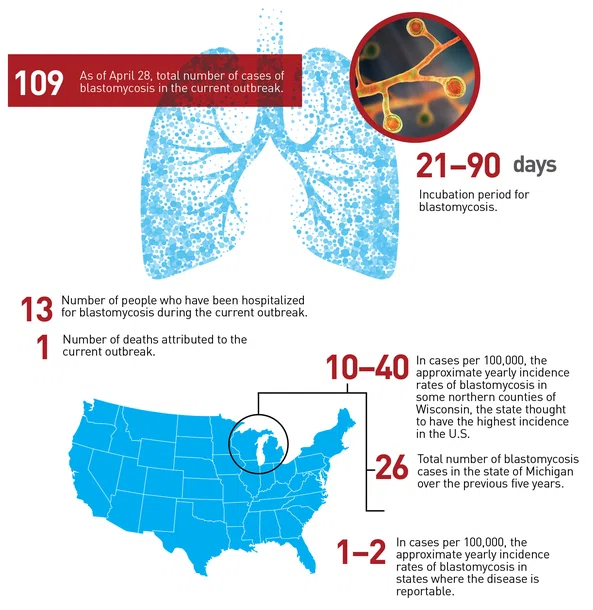

DEPARTMENTS
BY THE NUMBERS
Blastomycosis Outbreak in Michigan
In late February, public health authorities were notified that several people who worked at the Billerud paper mill in Escanaba, Michigan, were exhibiting symptoms of atypical pneumonia, which was later diagnosed as blastomycosis. The disease is associated with the fungus Blastomyces, which grows in moist soil and decomposing matter such as wood and leaves. People can get blastomycosis by breathing in fungal spores.
While everyone who has contracted the disease during the current outbreak was either a worker, contractor, or visitor at the paper mill, the source of the outbreak had not been identified as of early May. The fungus that causes blastomycosis is common to the environment in the Upper Peninsula of Michigan, where Escanaba is located.
Billerud idled the mill on April 13, as recommended by NIOSH, to allow the facility to be cleaned. At the request of Billerud, NIOSH performed a preliminary health hazard evaluation of the mill in late March.
Information about the outbreak appears below. All data are the latest available as of April 28, 2023.
While everyone who has contracted the disease during the current outbreak was either a worker, contractor, or visitor at the paper mill, the source of the outbreak had not been identified as of early May. The fungus that causes blastomycosis is common to the environment in the Upper Peninsula of Michigan, where Escanaba is located.
Billerud idled the mill on April 13, as recommended by NIOSH, to allow the facility to be cleaned. At the request of Billerud, NIOSH performed a preliminary health hazard evaluation of the mill in late March.
Information about the outbreak appears below. All data are the latest available as of April 28, 2023.
From the April 28, 2023, Blastomycosis Outbreak Investigation Update provided by Public Health Delta & Menominee Counties:
“Those who [contract blastomycosis] can develop symptoms such as cough (sometimes with blood), fever, chest pain, difficulty breathing, night sweats, fatigue, weight loss, muscle aches, and joint pain. [. . .] Most people with blastomycosis will need treatment with prescription antifungal medication. Depending on the severity of the infection and the person’s immune status, the course of treatment can range from six months to one year.”

SOURCES
CDC: “Blastomycosis Statistics.”
NIOSH: “NIOSH Investigates Workplace Outbreak of Blastomycosis.”
Public Health Delta & Menominee Counties: Blastomycosis Investigation.
Tap on the graphic to open a larger version in your browser.